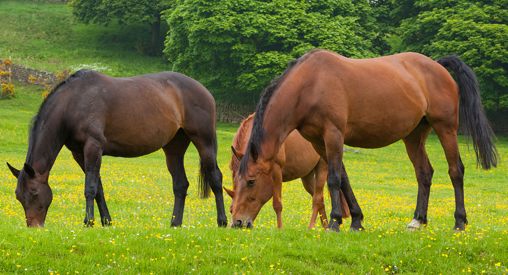
How to spot a horse in pain
Sometimes it can be hard to tell when a horse is hurting. But a clever assessment tool, designed by Dr Sue Dyson, Head of Clinical Orthopaedics at the Animal Health Trust (AHT), can help owners assess pain by looking at clues in their horse's facial movements
Vets are usually familiar with the telltale signs, but for owners it can be a real challenge to differentiate between pain and bad behaviour. 'Riders can sometimes miss that a horse might have a physical problem, which is compromising his performance,' explains Sue. 'They often think there has to be reason why a horse is unwilling to do a certain thing - that he is being grumpy or that they are not giving the correct signal. Pain is often the last thing people think about.' Sue has designed an equine ethogram - a catalogue of behaviours - that allows owners, riders and trainers to gain an insight into a horse's health immediately, just by looking at him.
How the ethogram works
Sue looked at hundreds of photographs of horses' faces and, in collaboration with colleagues and animal behaviour experts, designed a pain score for each part of the face. Ear position, for example, was given a score from zero to three. Both ears forwards was associated with no pain and given a zero, while both ears back was associated with pain so it scored a three. 'We did the same for the eyes, mouth and head position,' explains Sue.
After testing the ethogram, to ensure that it worked, with both equine professionals and non-professional horse owners, the next stage involved asking a trained assessor to study photographs of healthy and lame horses to see if they could differentiate between the two based on their facial expressions. 'Statistical analysis showed that there were significant differences,' says Sue.
At the same time, a small number of the lame horses were tested before and after nerve-blocking, to ascertain whether removing their pain made a difference to their facial expressions.
'We found that the pain scores were substantially reduced after the pain had stopped,' she adds.
Next, Sue developed a whole horse ethogram, which looked at all aspects of the horse's behaviour when it was being ridden. The results were very clear.
'We looked at 117 different behaviours and found 24 that were 10 times more likely to be seen in lame horses' explains Sue, who concluded that the presence of eight or more of these 24 behaviours was 'highly likely to reflect the presence of pain'.
'People say, "He has always done that", but now vets can reply, for example: "Yes, he has scored eight or more and is therefore likely to have been in musculoskeletal pain since you've owned him",' she says.
More information on the ethogram can be found on the Animal Health Trust website [www.aht.org.uk].
Does your horse have pain written all over his face?
Different horses react differently to pain, so it is impossible to say that a particular behaviour points toward a certain health issue. There are, however, some telltale behaviours that could be indicative of a specific problem. Study him closely and you may find clues.
What should you do if you suspect your horse may be in pain?
'Monitor him carefully,' suggests Gil. 'And ask yourself: have there been any recent changes to his management, equipment or workload? Has he recently been shod? Keep a diary and relay your concerns to your vet.'
Sue concludes: 'The sooner pain and lameness are detected and diagnosed, the better the prognosis as you are limiting the damage.'
1. Ears
There may be something amiss in a horse that has his ears back for more than five seconds at a time while being ridden.
2. Eyes
A horse that's hurting might have a glazed expression, tense the muscles around his eyes, or even close them momentarily during ridden exercise.
3. Mouth
A horse in discomfort might show a degree of separation of the teeth and have his tongue sticking out to a varying extent.
4. Head position
A normal, trained horse has the front of the head in a vertical position (on the bit). Being consistently over-bent or above the bit may reflect pain.
Excessive head movement could also be a sign of lameness, mouth pain caused by teeth or bitting issues, or head-shaking. Gil says: 'Head tossing can indicate any number of different issues. Some are resolvable, but head-shaking is a serious condition that can become a welfare issue.'
5. Inconsistent or fussy eating
This could be a sign of stomach ulcers. 'If your horse has a varying appetite, is reluctant to eat hard starch or high-fibre foods [both can irritate ulcers] and doesn't want to go forward when being ridden, then it is worth ruling out ulcers,' advises Petplan Equine veterinary expert, Gil Riley.
6. Bucking or kicking out after a fence
This could be a sign of back pain, including sacroiliac pain and kissing spines. 'Bucking or kicking out after a fence, or objecting to moving forward into trot or canter, are often blamed on disobedience or exuberant behaviour when in fact they could be a sign of a physical issue,' says Gil.
Furthermore, vets now believe there is a strong correlation between kicking out after a fence and pain in the sacroiliac area.
7. Switching leads behind in canter or just not feeling 'quite right'
This could be a sign of hind leg lameness, including suspensory ligament desmitis (inflammation of the suspensory ligament). When lameness affects the hind legs it can often be difficult to detect.
'It may not be easily recognisable in trot, especially if both hind legs are affected, but when the horse bunny-hops or changes leads regularly in canter, this can be a sign that something is not right,' says Gil. 'Suspensory ligament desmitis can affect both legs and because it can creep up over time it makes it even more difficult to pin-point.'











